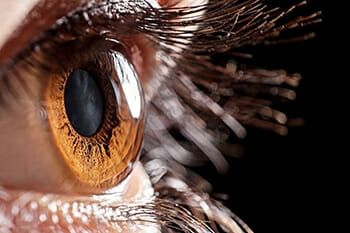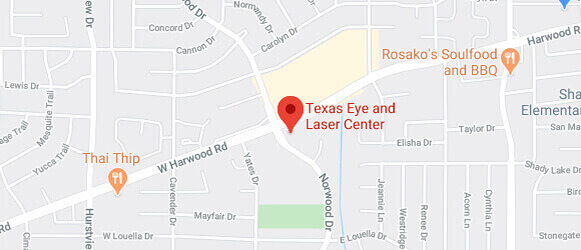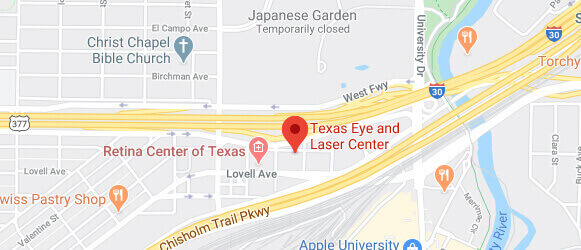DMEK
 Corneal dystrophies are a group of genetic eye disorders in which abnormal material accumulates on the cornea, the clear, transparent front portion of the eye. These eye disorders can cause swelling in the cornea, leading to blurred vision. Over time, permanent vision loss can occur.
Corneal dystrophies are a group of genetic eye disorders in which abnormal material accumulates on the cornea, the clear, transparent front portion of the eye. These eye disorders can cause swelling in the cornea, leading to blurred vision. Over time, permanent vision loss can occur.
Patients who have been diagnosed with corneal dystrophy may be candidates for a corneal transplant procedure. Descemet’s Membrane Endothelial Keratoplasty (DMEK) is one such procedure that involves removing the old Descemet’s membrane and corneal endothelium (the innermost portion of the cornea) and replacing it with a donor membrane and endothelium.
The procedure is an alternative to standard corneal transplants that remove the full thickness of the cornea. Because it is a partial corneal transplant, DMEK results in faster healing and visual recovery than standard corneal transplants.
With many years of experience, the cornea specialists at Texas Eye and Laser Center have performed countless corneal procedures, including DMEK. Combining expert training and skill with the most up-to-date technology and surgical methods, Texas Eye and Laser Center have helped patients restore clear and healthy vision with DMEK.
When Is DMEK Appropriate?
DMEK is designed to treat blurry vision caused by a dysfunction of the endothelium. When an eye loses too many endothelial cells, it is not able to maintain the proper corneal thickness and clarity, resulting in distorted vision. Endothelial failure can be caused by disease (e.g., Fuchs’s Dystrophy) or trauma following cataract or glaucoma surgery.
Since DMEK is a partial corneal transplant, it is an appropriate treatment option when there is corneal clouding due to a dysfunction of the endothelium but the other layers of the cornea remain healthy. Prior to treatment, our team will carefully examine your eye in order to determine whether DMEK or another surgical option is best.
About the Procedure
DMEK is an in-office procedure that takes approximately 30 minutes to complete. To begin, your eyes will be numbed with a topical anesthetic to minimize discomfort. Your eye surgeon will then make a small incision on the side of the cornea to access the diseased endothelial layer. This layer will then be peeled from the back of the cornea, leaving the healthy remainder intact. Healthy corneal tissue (known as a donor disc) will be placed inside the eye, replacing the diseased layer. Once complete, a bandage will be placed to protect your eye and aid in healing.
Recovery Details
After the procedure, our team will provide you with a comprehensive list of guidelines to follow during your recovery process. Some discomfort is to be expected following surgery. Our team may prescribe medications to help minimize discomfort and aid healing. You are advised to rest as much as possible, with your head elevated as much as possible for the first 24 hours after surgery.
Regular follow-ups with our team are required in order to monitor your healing progress. Our team will determine when it is safe to resume normal activities after meeting with you during a follow-up appointment.
Superficial Keratectomy (SK)
The cornea is the transparent front layer of the eye that protects the eye from bacteria and debris. It also plays an integral part in clear vision. When a cornea becomes damaged, scarred or opaque, a superficial keratectomy (SK) procedure may be necessary to restore clear vision. The procedure involves removing damaged cells on the epithelium, the outermost layer of the cornea, and then smoothing the corneal surface.
The eye surgeons at Texas Eye and Laser Center have years of experience performing corneal procedures, including SK. To determine whether SK is right for you, please schedule a consultation with us. Or, continue reading to learn more about SK.
When is Superficial Keratectomy Necessary?
SK is designed to treat common ocular surface diseases including:
- Anterior basement membrane dystrophy, an abnormality of the epithelium and basement membrane that causes corneal erosions or scar tissue formation.
- Salzmann’s nodular degeneration, which is characterized by callous-like scar tissue that forms under the corneal epithelium. The condition commonly occurs due to corneal inflammation.
- Calcific band keratopathy, the accumulation of calcium in the anterior cornea due to corneal disease, intraocular disease or hereditary deposition.
- Other anterior opacities that do not involve deeper layers of the cornea.
Patients with ocular surface diseases can experience a variety of symptoms including dryness, irritation, pain, recurrent erosion, and blurred vision. Early and minor symptoms of these diseases can be managed through eye lubrication and other medications. However, more severe cases may require surgical intervention.
About Superficial Keratectomy
SK is designed to remove scar tissue and defective surface cells that form on the surface of the cornea. In this procedure, the corneal epithelial surface cells are removed and then the scar tissue is peeled off the front of the cornea. Healthy epithelial cells will then heal over several days following the procedure.
When the corneal tissue extends into the upper portions of the cornea’s stromal layer, an excimer laser is used, instead of the handheld instrument, to remove the scar tissue, in a procedure called phototherapeutic keratectomy (PTK). Prior to your procedure, our team will conduct a thorough eye examination of your eye, in order to determine which treatment is best for your condition.
Procedure Details
SK is an in-office procedure that can be completed in about 20 minutes. Prior to treatment, the eyes will be numbed to ensure patient comfort. Our doctors will mechanically remove the diseased epithelium using a blunt, handheld instrument, similar to a tiny spatula. A diamond burr is also used to smooth out the corneal surface smoothly and finely. Once finished, a bandage contact lens will be placed on the eye to protect the healing cells and minimize discomfort.
Most patients are able to resume normal activities a few days after surgery. We will prescribe eye drops to minimize discomfort and aid in healing. Temporary post-op side effects include a mild scratching sensation or light sensitivity. Anti-inflammatory drops can be used to promote good healing. We will remove the temporary bandage contact within one week after surgery. Vision typically improves within two weeks after surgery and should stabilize within two months after surgery.
Learn More from Texas Eye and Laser Center
To learn more about SK, please call the trusted eye surgeons at Texas Eye and Laser Center. Schedule your one-on-one consultation by calling (817) 540-6060 today.
Femtosecond Laser-Assisted Lamellar Keratoplasty (FALK)
For decades, advances in laser technology have made way for more accurate and precise results in refractive surgery. More recently, femtosecond lasers have been used to increase the accuracy and success of corneal transplantations. Femtosecond laser-assisted lamellar keratoplasty (FALK) is an innovative procedure used to treat patients whose vision has been compromised due to damage to the cornea. Clinical studies have shown that the use of femtosecond lasers in lamellar keratoplasty can lead to better visual outcomes and faster recovery for patients.
At Texas Eye and Laser Center, our eye surgeons are some of the top corneal specialists in the nation. By combining expert training and the latest technology, we are able to provide patients with the best visual outcomes and quality care.
When Is a Corneal Transplant Necessary?
The cornea is the transparent tissue that covers the front of the eye. It serves an important role in achieving clear vision, as well as keeping the eye healthy and free of infection. When the cornea becomes damaged by injury, disease, or infection, vision problems can occur. In these cases, a cornea transplant may be necessary to restore vision.
There are two types of cornea transplants: penetrating cornea transplant and lamellar cornea transplant. A penetrating cornea transplant involves removing all layers of the cornea, while a lamellar transplant involves removing selective layers. During your consultation, our experienced corneal surgeons will examine your eye to diagnose your condition and determine the cause of your corneal trauma. Using this information, they will determine whether a partial or full corneal transplant is necessary.
About FALK
FALK is a new corneal transplant technique that is used to treat patients with superficial corneal scarring and dystrophies that affect vision. It is a partial transplant procedure, and therefore is less invasive than a full corneal transplant and involves a shorter recovery. This also means there is less risk of post-op complications and graft rejection.
The difference between FALK and standard corneal transplants is that a laser is used to prepare the corneal transplant graft instead of a handheld blade called a trephine. We believe that the laser more accurately prepares the tissue and also can create specialized edge shapes. The laser is also better able to match the recipient to the donor tissue shape, which can eliminate the need for sutures. Ultimately, this results in more precise results, quicker recovery, and a better optical and visual outcome.
Procedure Details
FALK is performed on an outpatient basis under local anesthesia and takes approximately one hour to complete. Once anesthetized, your eye doctor will use the femtosecond laser to remove the damaged corneal tissue. The laser will also be used to size and attach the donor tissue in place. Once complete, a bandage contact lens will be placed to protect the eye as it heals. Post-op side effects may include inflammation, infection, suture-related problems, and graft rejection. Our team will monitor your healing progress closely to monitor your healing process closely to encourage a successful recovery.
DSAEK Corneal Treatment in Fort Worth & Hurst, TX
DSAEK is a corneal surgery procedure for severe cases of corneal disease or for damaged corneas. The procedure is similar to the traditional cornea transplant as both use donor corneas to replace damaged or diseased corneas. The difference is that DSAEK replaces only the damaged posterior section of the cornea, rather than the entire cornea in a traditional corneal transplant. This procedure, which requires no suturing, allows more rapid visual restoration, less discomfort, and a reduced risk of sight-threatening complications.
The new tissue is held in place with air in the eye for the day of surgery so that no sutures are needed. On the day of surgery, you must lie flat on your back so the air can push up into the cornea and hold the new tissue in position. Once it sticks to your cornea, it will begin to function and pump the water out of your cornea. Your vision will improve fairly rapidly and final visual results can be obtained in 1-6 months. Glasses are prescribed as needed. Even though only a portion of the cornea is transplanted, problems can still arise.
Fuchs’ Dystrophy patients are the primary group of patients needing a DSAEK procedure. Fuchs’ endothelial dystrophy (FED) is a degenerative disorder of the corneal endothelium caused by surgery or trauma, leading to corneal edema and loss of vision. When there are not enough endothelial cells, water can build in the cornea causing vision loss. DSAEK is a technique that replaces just the endothelial layer. The damaged cells are stripped from the eye and replaced with a very thin back portion of a donor cornea.
Patients first receive a full evaluation and testing at the Texas Eye and Laser Center so our doctors can best determine the patient’s vision treatment options, including the need for DSAEK surgery.
Photo-Therapeutic Keratectomy
The excimer laser may provide a novel modality in the treatment of a number of superficial corneal disorders. This treatment is known as phototherapeutic keratectomy or PTK. Whether PTK is used alone or as an adjunctive strategy in traditional corneal surgical techniques, a number of disorders affecting the corneal surface may be successfully treated by taking advantage of the excimer laser’s ability to meticulously remove superficial corneal tissue. These include a variety of corneal degenerations and dystrophies, corneal irregularities, and superficial scars.
While some of these conditions could be treated by mechanical superficial keratectomy techniques, PTK may minimize tissue removal and surgical trauma. The smoother stromal surface achieved by the excimer laser procedure may improve the surface smoothness of the cornea, postoperative corneal clarity, postoperative scarring, and subsequent epithelial adhesion. Moreover, superficial corneal disorders that would in some cases require corneal transplant may instead be treated with the PTK procedure.
Phototherapeutic Keratectomy might be for those of any age who have corneal surface diseases such as:
- Types of corneal scars that might be thin or not deep
- Epithelial erosion syndrome (erosion of the outer part of the cornea)
- Corneal dystrophies
Contact Texas Eye and Laser Center
To discuss your eye concerns or to learn more about DMEK, please schedule a one-on-one consultation with Texas Eye and Laser Center. Please call (817) 540-6060 today.




